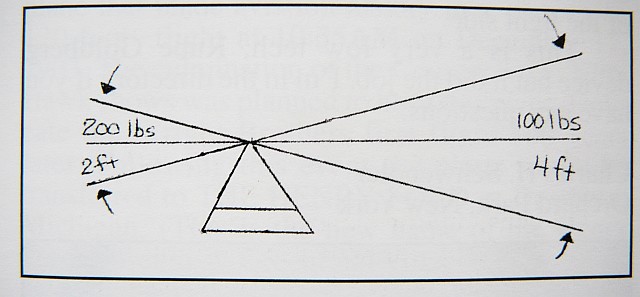What do people mean when they talk about putting higher gears in their rear end? Why do they do it (and if it is so good, why didn't Ford do it in the first place?)
Everyone seems to want to as fast as they can. Higher gears can help them do that. If 3.55 gears are good, wouldn't 3.00 or 2.50 be even better?
In engineering, as in life, most things are a compromise. The higher the gear ratio, the faster the vehicle can go, at least in theory. The engine has to have enough power to achieve and maintain this higher speed. Even if the engine can get the vehicle to the higher speed, with the higher gears it will take longer to do so. If it has lower gears, it will be able to accelerate to a given speed quicker.
Consider a teeter-totter. If it is pivoted in the center and two people of the same weight sit at the same distance from the pivot, they will balance each other. The rotational force that they produce will be equal. When they go up and down, each moves the same distance and at the same speed.

If one person weighs twice as much s the other, the heavier person would have to sit one-half as far from the pivot for the teeter-totter to balance. But, when this combination moves up and down, the person twice as heavy, sitting half as far from the pivot, would move only half as far up and down as the lighter person. The heavier person would also move only half as fast as the lighter person.
This is basic mechanical advantage. You can see that the lighter person can produce the same rotational force as the heavier person only if the lighter person travel farther. Because this happens in the same amount of time, you can see also that the lighter person is moving faster. The lighter person requires the additional mechanical advantage of moving farther and faster to balance the heavier person.
How does this apply to our vehicles? Think of the engine as being the lighter person. The torque available to move a 2500 - 3500 lb vehicle is in the 200 - 300 foot-pound area. The engine needs help, in terms of mechanical advantage, to get that weight moving. It requires less help to keep the weight moving at a steady speed. That is why you need lower gears to start from a stop than you do for maintaining cruising speed. That is also why trucks, which are heavier -- especially when loaded -- usually have lower gear ratios than passenger cars.
Gear ratios state the mechanical advantage that the engine employs to move the vehicle. A rear end ratio of 4:1 means that when the transmission is in top gear, the engine turns four times for each one time that the rear wheels turn. If the transmission has a ratio of 3:1 in first gear, then the overall ratio is 12:1, good for moving from a stop. The total or overall ratio is determined by multiplying the rear end ratio by the transmission ratio.
Lower gears give better acceleration and are easier on clutches, but are harder on tires. Higher gears may give higher cruising speeds with less noise and perhaps better fuel economy and less wear on the engine.
Ford probably used lower gears than would be suitable today because of poorer roads with lower speeds and the need to provide more pulling power for the everyday needs of folks "back then".
Using gears that are too high can cause poorer fuel economy, engine overheating, and damage.
The renowned Lincoln Zephyr gears
What is the reason for Lincoln Zephyr transmission gears? They are not stronger than Ford gears, but first and second are higher ratio. That means that they are spaced closer to each other, and to third gear. If you have increased the power of your engine and your vehicle is relatively light, you may not need as much overall reduction in first gear to get moving. Having the ratios closer can keep the RPM more closely in its efficient or effective RPM range.
That is why they were, and are, popular in the Dry Lakes, drag race cars, and hot street cars.
